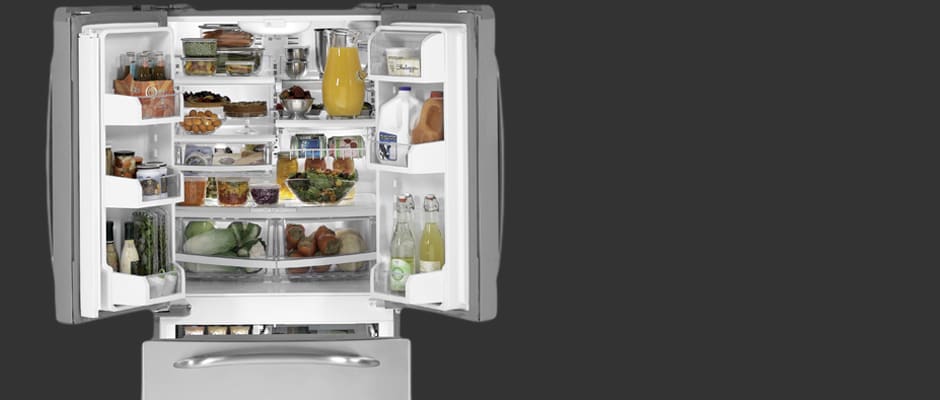Introduction
But the worst offender may be the price. For the GE's MSRP of $2,299, you can find models with either substantially sleeker appearances, or cheaper models with equal performance. We did manage to find sale prices as low as $1,786, however, which makes this otherwise average appliance a bit more attractive.
Design & Usability
{{section_header}}{{section.name}}{{/section_header}}
The thick white plastic trim and wire freezer shelves keep this fridge from feeling like a truly high-end appliance.
Like all French door models, this stainless steel appliance has two doors on top that open from the middle and reveal the interior of the fridge compartment. Below that is the drawer-like freezer, accessed by pulling out the large rectangular door. Like all stainless steel appliances, the GE Profile is prone to smudging and fingerprints.
The handles are also stainless, but are finished with a vertical grain that doesn't smudge as easily as the doors. The freezer handle curves down at both ends, giving the fridge a rather smug or disapproving appearance, depending on your imagination.
While many French door fridges combine the ice and water dispenser into one unit, this GE Profile does not. The external dispenser is for water only, and its inexpensive plastic exterior looks somewhat out of place.
The inside of this appliance has a clean, utilitarian appearance. There are four half-width shelves that mount on hooks in the rear, as well as a full-width fixed shelf on the bottom. A deli drawer is mounted to the bottom of a half shelf, and two vegetable drawers with independent humidity controls mirror each other further below.
On the doors are self-contained bucket shelves. The door on the right is identical to the one on the left, with one exception: Instead of having two larger shelves, one is replaced by a dairy bin located at the top. This model comes with two small plastic dividers that can be attached to any of the five standard door shelves. Since there's no through-the-door ice, there's no icemaker interrupting the fridge.
The pull-out freezer uses plastic wire shelves and is divided into four sections. Attached to the door is a large wire drawer that will hold the bulk of your frozen foods. Right above that is a short, full-width drawer labeled the “Slide N’ Store”, suitable for flat items like frozen pizzas and microwavable dinners. The top right is home to the “Full Slide Out” storage bin, a half-width wire drawer that can house all but the widest items. To its left is the ice maker, which has a cover that leaves a small amount of space available for tiny items such as pints of ice cream or ice packs.
{{photo_gallery "Front Photo", "Fingerprints Photo", "Handle Photo", "Handle Detail Photo", "Water/Ice Dispenser Photo", "Water/Ice Dispenser Controls Photo", "Water/Ice Dispenser Detail Photo", "Interior Photo", "Refrigerator Main 1 Image", "Refrigerator Main 2 Image", "Refrigerator Main 3 Image", "Water Filter Photo", "Refrigerator Door 1-1 Image", "Refrigerator Door 1-2 Image", "Refrigerator Door 1-3 Image", "Refrigerator Door 2-1 Image", "Refrigerator Door 2-2 Image", "Refrigerator Door 2-3 Image", "Freezer Main 1 Image", "Freezer Main 2 Image", "Freezer Main 3 Image", "Freezer Door 1 Image", "Freezer Door 2 Image", "Freezer Door 3 Image", "Ice Maker Photo", "Back Photo", "Back Detail Photo", "Sides Photo", "Side Detail 1 Photo", "Side Detail 2 Photo", "Fridge Temperature Image", "Freezer Temperature Image", "Vegetable Drawer Photo", "Vegetable Drawer Controls Photo", "Ease of Access Photo", "Controls Photo", "Cleaning Photo", "Other Features Photo"}}
Features
{{section_header}}{{section.name}}{{/section_header}}
A traditional design makes for a fairly easy-to-use appliance, though the ice maker is poorly positioned.
There is nothing terribly special about this French door fridge. Most of the shelves are reasonably accessible, and the freezer should pose no problem except to consumers with bad backs or limited mobility issues. The only thing that’s a pain to reach is the power switch on the ice maker, which is buried far in the back of the freezer.
The front control panel runs the water dispenser, fridge, and freezer. Those buttons are clearly labeled and quite responsive. One nifty extra function is called Turbo Cool, which puts the fridge into a state of fast chill. The manual states this is ideal for refrigerating warm food or restoring your ideal temperature quickly after a power outage has ended.
While the cheap-looking water dispenser itself has no issues doing what it’s supposed to, the paddle can be a bit frustrating if you’re not paying attention. It hardly depresses at all, which means you’re more likely to accidentally turn it on (unless you activate the control lock). The filter, pleasantly enough, is quite easy to change and fairly simple to get to as long as you don’t have piles of food in front of it.
The ice maker is a self-contained unit that is controlled by flipping a switch on the device itself. Ice is stored in a pull-out bin set underneath the actual ice maker. It’s rather small, meaning you have more room for actual food but may have to wait for ice if you have a party. Also, there’s no ice dispenser on the front of the fridge, so you’ll have to stoop and scoop if you want a cold beverage.
Performance
{{section_header}}{{section.name}}{{/section_header}}
Excellent moisture retention is enough to draw attention to this fridge, despite some less-than-perfect temperature consistency.
Despite having a wide open fridge where air can circulate freely, the temperature consistency from top to bottom wasn’t as good as we’d hoped. Luckily, temperatures remained very consistent over time, fluctuating less than a quarter of a degree on average.
The freezer had similar problems to those found in the fridge, specifically a minor gap in temperature from top to bottom. You’d think that air flow between the open wire shelves would keep things more consistent, but we pack it full of frozen items—just like you do! Temperatures here were also quite consistent, fluctuating from about half to one-quarter of a degree over time. That’s a small enough difference that your food should be quite safe from freezer burn.
Moisture retention in the GE Profile’s vegetable drawer was exceptional. If you like to buy lots of fruits and vegetables on sale and eat them during the week, they may be almost as juicy or crispy as the day you bought them.
The GE Profile PFSS2MJYSS will cost a consumer about $50.31 per year to operate. This may seem like a lot, and it's true that this machine isn’t cheap to operate. However, compared to many French door fridges of its size, this is actually a reasonable amount to pay.
Conclusion
{{section_header}}{{section.name}}{{/section_header}}
The moisture retention in the vegetable drawer was great, but that's the only remarkable thing about this GE.
It's easy to rag on a bad fridge or praise a great one, but it's difficult to capture the essence of a truly average appliance. The GE Profile PFSS2MJYSS is so middle-of-the-road that it could very easily disappear from appliance retailers without anyone noticing.
The main issue is its $2,299 MSRP. For a price tag that high, there are some above-average fridges out there more worth your consideration. But if you can find it on sale—and we did, with prices as low as $1,786—it may be worth a closer look.
Science Introduction
{{section_header}}{{section.name}}{{/section_header}}
Some wonky temperature issues in both the fridge and freezer keep this appliance from getting perfect marks. There aren’t any huge issues, though, and the temperature disparities are low enough to be offensive more on principle than anything else. Excellent moisture retention is a big plus and this GE kept food frozen for some time when power was cut, but freezing times were slower than average.
Fridge Performance
{{section_header}}{{section.name}}{{/section_header}}
The one noteworthy feature on this fridge is its excellent vegetable drawer.
Though the display on the front of the fridge read 37 degrees Fahrenheit, food on the top shelves of the fridge got as warm as 40 degrees, while food in the middle of the fridge got as cool as 36. Four degrees isn’t a huge gap, but it’s still big enough to take notice. You’ll have to be careful about where you store your food, keeping items that are more perishable (such as soft cheese and yogurt) in the cooler portions.
The GE Profile PFSS2MJYSS lost moisture at a rate of 0.15 grams per hour in its vegetable drawer, which is an excellent result. Produce kept in this drawer will stay fresher longer, at least compared to many other fridges; fruits and vegetables will taste almost as good as the day you bought them.
{{photo_gallery "Science Section 1 Images"}}
Freezing Performance
{{section_header}}{{section.name}}{{/section_header}}
A longer than average freezing time may affect food quality.
It’s perhaps a bit disappointing that this freezer took as long as it did to lower our room temperature items. Starting out at a heat level of about 71 degrees Fahrenheit, it took this appliance one hour and 41 minutes to bring it down to freezing. This is a bit longer than average and could potentially effect the quality of food once thawed, especially meats.
Once frozen, food at the top of the freezer hovered around the ideal 0 degrees Fahrenheit, while food in the lower portion got up to about 3 degrees. Again, like the temperatures in the fridge, it’s not a huge gap, and your food shouldn't be affected by such a gap.
{{photo_gallery "Science Section 2 Images"}}
Power Loss
{{section_header}}{{section.name}}{{/section_header}}
No need to worry about food thawing in case of a power outage
After 36 hours without power, the GE Profile’s freezer hadn’t even broken 30 degrees. This appliance is sure to keep your food preserved for a power outage of average length, and the Turbo Cool feature will help to chill any items that have thawed for whatever reason.
{{photo_gallery "Science Section 3 Images"}}
Other Tests
{{section_header}}{{section.name}}{{/section_header}}
{{photo_gallery "Other Tests Images"}}
Meet the tester
Matthew is a native of Brockton, MA and a graduate of Northeastern, where he earned a degree in English and Theatre. He has also studied at the Gaiety School of Acting in Dublin and spends most of his free time pursuing a performance career in the greater Boston area.
Checking our work.
Our team is here to help you buy the best stuff and love what you own. Our writers, editors, and experts obsess over the products we cover to make sure you're confident and satisfied. Have a different opinion about something we recommend? Email us and we'll compare notes.
Shoot us an email

